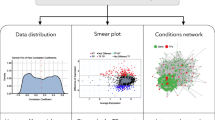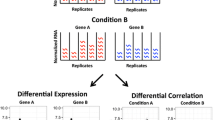Abstract
Growth is regulated by gene expression variation at different developmental stages of biological processes such as cell differentiation, disease progression, or drug response. In cancer, a stage-specific regulatory model constructed to infer the dynamic expression changes in genes contributing to tissue growth or proliferation is referred as a dynamic growth regulatory network (dGRN). Over the past decade, gene expression data has been widely used for reconstructing dGRN by computing correlations between the differentially expressed genes (DEGs). A wide variety of pipelines are available to construct the GRNs using DEGs and the choice of a particular method or tool depends on the nature of the study. In this protocol, we have outlined a step-by-step guide for the analysis of DEGs using RNA-Seq data, beginning from data acquisition, pre-processing, map** to reference genome, and construction of a correlation-based co-expression network to further downstream analysis. We have also outlined the steps for the inclusion of publicly available interaction/regulation information into the dGRN followed by relevant topological inferences. This tutorial has been designed in a way that early researchers can refer to for an easy and comprehensive glimpse of methodologies used in the inference of dGRN using transcriptomics data.
Access this chapter
Tax calculation will be finalised at checkout
Purchases are for personal use only
Similar content being viewed by others
References
Baute J, Herman D, Coppens F, De Block J, Slabbinck B, Dell’Acqua M, Pè ME, Maere S, Nelissen H, Inzé D (2016) Combined large-scale phenoty** and transcriptomics in maize reveals a robust growth regulatory network. Plant Physiol 170(3):1848–1867
Baena-Lopez LA, Nojima H, Vincent JP (2012) Integration of morphogen signalling within the growth regulatory network. Curr Opin Cell Biol 24(2):166–172
Claeys H, De Bodt S, Inzé D (2014) Gibberellins and DELLAs: central nodes in growth regulatory networks. Trends Plant Sci 19(4):231–239
Carey M, Ramírez JC, Wu S, Wu H (2018) A big data pipeline: Identifying dynamic growth regulatory networks from time-course Gene Expression Omnibus data with applications to influenza infection. Stat Methods Med Res 27(7):1930–1955
Hurd PJ, Nelson CJ (2009) Advantages of next-generation sequencing versus the microarray in epigenetic research. Brief Funct Genom Proteom 8(3):174–183
Contreras-López O, Moyano TC, Soto DC, Gutiérrez RA (2018) Step-by-step construction of gene co-expression networks from high-throughput Arabidopsis RNA sequencing data. Methods and Protocols, Root Development, pp 275–301
Hecker M, Lambeck S, Toepfer S, Van Someren E, Guthke R (2009) Growth regulatory network inference: data integration in dynamic models-a review. Bio Systems 96(1):86–103
Stark R, Grzelak M, Hadfield J (2019) RNA sequencing: the teenage years. Nat Rev Genet 20(11):631–656
de Jong H (2002) Modeling and simulation of genetic regulatory systems: a literature review. J Comput Biol 9(1):67–103
Jänes J, Hu F, Lewin A, Turro E (2015) A comparative study of RNA-seq analysis strategies. Brief Bioinform 16(6):932–940
Costa-Silva J, Domingues DS, Menotti D, Hungria M, Lopes FM (2022) Temporal progress of gene expression analysis with RNA-Seq data: a review on the relationship between computational methods. Comput Struct Biotechnol J 21:86–98
Ding J, Bar-Joseph Z (2020) Analysis of time-series regulatory networks. Curr Opin Syst Biol 21:16–24
Steuer R, Kurths J, Daub CO, Weise J, Selbig J (2002) The mutual information: detecting and evaluating dependencies between variables. Bioinformatics 18(suppl_2):S231–S240
Thomas R (1973) Boolean formalization of genetic control circuits. J Theor Biol 42(3):563–585
Stuart JM, Segal E, Koller D, Kim SK (2003) A gene-coexpression network for global discovery of conserved genetic modules. Science 302(5643):249–255
Shmulevich I, Dougherty ER, Kim S, Zhang W (2002) Probabilistic Boolean Networks: a rule-based uncertainty model for growth regulatory networks. Bioinformatics 18(2):261–274
Friedman N, Linial M, Nachman I, Pe’er D (2000) Using Bayesian networks to analyze expression data. J Comput Biol 7(3–4):601–620
Perrin BE, Ralaivola L, Mazurie A, Bottani S, Mallet J, d’Alche–Buc F (2003) Gene networks inference using dynamic Bayesian networks. Bioinformatics 19(Suppl_2):ii138–ii148
Bar-Joseph Z, Gitter A, Simon I (2012) Studying and modelling dynamic biological processes using time-series gene expression data. Nat Rev Genet 13(8):552–564
Spies D, Ciaudo C (2015) Dynamics in transcriptomics: advancements in RNA-seq time course and downstream analysis. Comput Struct Biotechnol J 13:469–477
Oh S, Song S, Grabowski G, Zhao H, Noonan JP (2013) Time series expression analyses using RNA-seq: a statistical approach. BioMedResearch Int 2013:203681
Van Dam S, Vosa U, van der Graaf A, Franke L, de Magalhaes JP (2018) Gene co-expression analysis for functional classification and gene–disease predictions. Brief Bioinform 19(4):575–592
Singh R, Som A (2020) Role of network biology in cancer research. Recent trends in ‘Computational Omics’: concepts and methodology. Nova Science Publishers, New York
Morton ML, Bai X, Merry CR, Linden PA, Khalil AM, Leidner RS, Thompson CL (2014) Identification of mRNAs and lincRNAs associated with lung cancer progression using next-generation RNA sequencing from laser micro-dissected archival FFPE tissue specimens. Lung Cancer 85(1):31–39
Andrews S (2010) Babraham bioinformatics – FastQC a quality control tool for high throughput sequence data. https://www.bioinformatics.babraham.ac.uk/projects/fastqc/
Bolger AM, Lohse M, Usadel B (2014) Trimmomatic: a flexible trimmer for Illumina sequence data. Bioinformatics 30:2114–2120
Kim D, Langmead B, Salzberg SL (2015) HISAT: a fast spliced aligner with low memory requirements. Nat Methods 12:357–360
Thorvaldsdóttir H, Robinson JT, Mesirov JP (2013) Integrative Genomics Viewer (IGV): high-performance genomics data visualization and exploration. Brief Bioinform 14(2):178–192
Liao Y, Smyth GK, Shi W (2014) featureCounts: an efficient general purpose program for assigning sequence reads to genomic features. Bioinformatics 30:923–930
Love MI, Huber W, Anders S (2014) Moderated estimation of fold change and dispersion for RNA-seq data with DESeq2. Genome Biol 15(12):1–21
Shannon P, Markiel A, Ozier O, Baliga NS, Wang JT, Ramage D, Amin N, Schwikowski B, Ideker T (2003) Cytoscape: a software environment for integrated models of biomolecular interaction networks. Genome Res 13(11):2498–2504
Sherman BT, Hao M, Qiu J, Jiao X, Baseler MW, Lane HC, Imamichi T, Chang W (2022) DAVID: a web server for functional enrichment analysis and functional annotation of gene lists (2021 update). Nucleic Acids Res 50(W1):W216–W221
Lai Y (2010) Diferential expression analysis of digital gene expression data: RNA-tag filtering, comparison of t-type tests and their genome-wide co-expression-based adjustments. Int J Bioinforma Res Appl 6(4):353–365
Conesa A, Madrigal P, Tarazona S, Gomez-Cabrero D, Cervera A, McPherson A, Szcześniak MW, Gaffney DJ, Elo LL, Zhang X, Mortazavi A (2016) A survey of best practices for RNA-seq data analysis. Genome Biol 17(1):1–9
Ghosh A, Som A (2022) Transcriptomic analysis of human naïve and primed pluripotent stem cells. Human Naïve Pluripotent Stem Cells 2022:213–237
Wang L, Wang S, Li W (2012) RSeQC: quality control of RNA-seq experiments. Bioinformatics 28(16):2184–2185
Trapnell C, Roberts A, Goff L, Pertea G, Kim D, Kelley DR, Pimentel H, Salzberg SL, Rinn JL, Pachter L (2012) Differential gene and transcript expression analysis of RNA-seq experiments with TopHat and Cufflinks. Nat Protoc 7(3):562–578
Li B, Dewey CN (2011) RSEM: accurate transcript quantification from RNA-Seq data with or without a reference genome. BMC Bioinf 12:1–6
Roberts A, Feng H, Pachter L (2013) Fragment assignment in the cloud with eXpress-D. BMC Bioinf 14(1):1–9
Li D, Zand MS, Dye TD, Goniewicz ML, Rahman I, **e Z (2022) An evaluation of RNA-seq differential analysis methods. PLoS One 17(9):e0264246
Ghosh A, Som A (2021) Decoding molecular markers and transcriptional circuitry of naive and primed states of human pluripotency. Stem Cell Res 53:102334
Joehanes R (2018) Network analysis of gene expression. Methods Mol Biol (Clifton, NJ) 1783:325–341
Albert R, Barabási AL (2002) Statistical mechanics of complex networks. Rev Mod Phys 74(1):47
Ghosh A, Som A (2020) RNA-Seq analysis reveals pluripotency-associated genes and their interaction networks in human embryonic stem cells. Comput Biol Chem 85:107239
Chaturvedi A, Som A (2022) The LCNetWork: an electronic representation of the mRNA-lncRNA-miRNA regulatory network underlying mechanisms of non-small cell lung cancer in humans, and its explorative analysis. Comput Biol Chem 101:107781
Singh R, Som A (2020) Identification of common candidate genes and pathways for progression of ovarian, cervical and endometrial cancers. Meta Gene 23:100634
Hu Z, Mellor J, Wu J, Yamada T, Holloway D, DeLisi C (2005) VisANT: data-integrating visual framework for biological networks and modules. Nucleic Acids Res 33(suppl_2):W352–W357
Nikitin A, Egorov S, Daraselia N, Mazo I (2003) Pathway studio – the analysis and navigation of molecular networks. Bioinformatics 19(16):2155–2157
Suderman M, Hallett M (2007) Tools for visually exploring biological networks. Bioinformatics 23(20):2651–2659
Assenov Y, Ramírez F, Schelhorn SE, Lengauer T, Albrecht M (2008) Computing topological parameters of biological networks. Bioinformatics 24(2):282–284
Chin CH, Chen SH, Wu HH, Ho CW, Ko MT, Lin CY (2014) cytoHubba: identifying hub objects and sub-networks from complex interactome. BMC Syst Biol 8(4):1–7
Morris JH, Apeltsin L, Newman AM, Baumbach J, Wittkop T, Su G, Bader GD, Ferrin TE (2011) clusterMaker: a multi-algorithm clustering plugin for Cytoscape. BMC Bioinf 12(1):1–4
Acknowledgments
The authors thank Arindam Ghosh for reviewing the earlier version of the manuscript and for his valuable comments. AC is grateful to the University Grants Commission (India) for providing financial assistance to carry out the research work.
Author information
Authors and Affiliations
Editor information
Editors and Affiliations
Rights and permissions
Copyright information
© 2024 The Author(s), under exclusive license to Springer Science+Business Media, LLC, part of Springer Nature
About this protocol
Cite this protocol
Chaturvedi, A., Som, A. (2024). Inference of Dynamic Growth Regulatory Network in Cancer Using High-Throughput Transcriptomic Data. In: Mandal, S. (eds) Reverse Engineering of Regulatory Networks. Methods in Molecular Biology, vol 2719. Humana, New York, NY. https://doi.org/10.1007/978-1-0716-3461-5_4
Download citation
DOI: https://doi.org/10.1007/978-1-0716-3461-5_4
Published:
Publisher Name: Humana, New York, NY
Print ISBN: 978-1-0716-3460-8
Online ISBN: 978-1-0716-3461-5
eBook Packages: Springer Protocols




